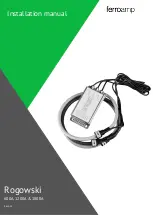
Section 1
1-1
Installation
General
The overall accuracy of temperature and other measurements depends on several
variables. Although the transmitter has an outstanding performance, proper installation is
essential in order to maximize its performance.
Among all factors which may affect transmitter accuracy, environmental conditions are
the most difficult to control. There are, however, ways of reducing the effects of
temperature, humidity and vibration.
Locating the transmitter in areas protected from extreme environmental changes can
minimize temperature fluctuation effects.
In warm environments, the transmitter should be installed in such a way as to avoid, as
much as possible, direct exposure to the sun. Installation close to lines and vessels
subjected to high temperatures should also be avoided. For temperature measurements,
sensors with cooling-neck can be used or the sensor can be mounted separately from the
transmitter housing.
Use of sunshades or heat shields to protect the transmitter from external heat sources
should be considered.
Humidity is fatal for electronic circuits. In areas subjected to high relative humidity, the O-
rings for the electronic housing covers must be correctly placed and the covers must be
completely closed by tightening them by hand until you feel the O-rings being
compressed. Do not use tools to close the covers. Removal of the electronics cover in the
field should be reduced to the minimum necessary, since each time it is removed, the
circuits are exposed to humidity. The electronic circuit is protected by a humidity proof
coating, but frequent exposure to humidity may affect the protection provided. It is also
important to keep the covers tightened in place. Every time they are removed, the threads
are exposed to corrosion, as painting cannot protect these parts. Code-approved sealing
methods should be employed on conduit entering the transmitter.
Connecting the sensor as close to the transmitter as possible and using proper wires
(See
Section 2 - Operation
), can decrease measurement error.
Mounting
The transmitter may be mounted in two basic ways:
Separated from the sensor, using optional mounting brackets.
Mounted on the sensor assembly.
It can be mounted in several different positions using the bracket, as shown in
Figure 1.3
- Dimensional Drawing and Mounting Positions
. As shown in
Figure 1.3 - Dimensional
Drawing and Mounting Positions
one of the conduit inlets for electrical connection is used
to mount the sensor integral to the temperature transmitter.
For better visibility, the digital display may be rotated in steps of 90
°
. (See
Figure 4.1 -
Four Possible Positions of the Display
).
Summary of Contents for TT302
Page 1: ......
Page 11: ...Installation 1 5 Figure 1 5 Tree Topology TT2EM105 CDR ...
Page 12: ...TT302 Fieldbus Temperature Transmitter 1 6 ...
Page 18: ...TT302 Fieldbus Temperature Transmitter 2 6 ...
Page 32: ...TT302 Fieldbus Temperature Transmitter 3 14 ...
Page 38: ...TT302 Fieldbus Temperature Transmitter 4 6 ...








































